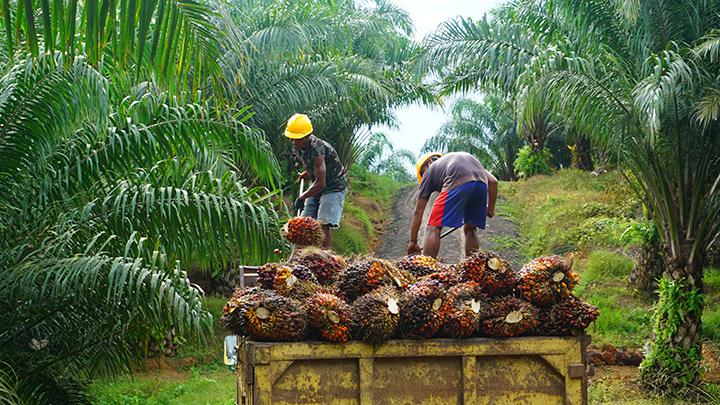In Indonesia’s palm oil sector, many small-scale growers are crying out: palm oil farmers struggle. Their complaints echo across plantations in Sumatra and Kalimantan, where fruit bunch prices swing wildly and land regulation lacks transparency. In this article we explore why they struggle, what factors contribute to this poor plight, and how policy and market shifts could offer relief.
Price Volatility Hits Palm Oil Farmers Hard
A major reason that palm oil farmers struggle is the unpredictable price of fresh fruit bunches (FFB). In May 2025, prices slumped again, prompting another wave of farmer distress. Many reported selling at just Rp 1,400–Rp 1,600 per kilogram, well below cost of production.
This price drop ties back to global supply-demand pressure, speculation in CPO markets, and regulatory changes like EU deforestation rules. Such volatility devastates finances. Farmers face shrinking margins, and many risk unable to buy fertilizer or pay labor.
Opaque Land Regulation Adds to Farmer Crisis
On top of price stress, palm oil farmers struggle due to confusing and opaque land reforms. Government efforts to clear illegal plantations have led to sudden sanctions. But transparency in identifying affected lands is lacking. Farmers say they are left guessing whether their plots are legal or not.
Without clear maps or official guidance, many face sudden seizures, risking long investments in land that later becomes contested. This insecurity discourages new planting or long-term improvements. For farmers already squeezed by low prices, the lack of predictable land status becomes another blow.
Supply Chain Pressures and Middlemen Margins
Another issue pushing palm oil farmers struggle is the dominance of middlemen. Farmers often must sell via buyers or intermediaries who set prices unilaterally. These middlemen take hefty margins while farmers absorb all the risk.
Lacking bargaining power or alternative markets, smallholders are at the mercy of these intermediaries. When international prices fall, middlemen lower offers without warning, leaving farmers without recourse. This power imbalance entrenches a cycle of low income and dependency.
Climate and Input Costs Compounding Struggle
Climate shifts make farming more unpredictable, tipping palm oil farmers struggle into deeper stress. In regions like Sumatra Selatan, excessive rain or drought damages yields and increases costs. Farmers pay more on fertilizer, often priced above Rp 7,000 per kilogram, while no subsidies arrive.
Combined with fluctuating world prices, drying or waterlogged plantations, and rising labor costs, farmers must choose between sustaining the land or cutting corners—risking future yields.
Policy and Market Reforms to Alleviate Farmer Pain
Recognizing that palm oil farmers struggle, reformers suggest several fixes:
- Transparent Land Registration: Publish clear maps of legal plantations, involve farmer cooperatives in verification to ensure legitimacy and avoid abrupt sanctions.
- Minimum Price Guarantees: Introduce floor prices or buffer funds to protect farmers from market dips. Some suggest tying prices to production cost plus sustainable margins.
- Limit Middlemen Influence: Encourage group marketing through cooperatives, enable direct sale to mills, improve transparency in pricing to reduce exploitation.
- Targeted Input Support: Provide subsidized fertilizer, improved seedlings, and crop insurance to landowners—especially during low-price periods or crop failure.
- Diversification Support: Help farmers diversify income, such as agroforestry or intercropping, reducing vulnerability when palm oil prices collapse.
Challenging the Status Quo
These farmers are not alone in their struggle. Trade unions, NGOs, and trade associations have voiced concerns. Many cite EU regulations and commodity speculation as while well-intentioned, they exacerbate palm oil farmers struggle without effective safeguards.
One proposed solution is merging agricultural and forestry oversight to better align land use and protect small growers—a move NGOs argue will reduce conflicting policy signals.
Long-Term Outlook and Hope
Despite tough realities, improving policies could help change the pattern. Where transparent land titles exist, some farmers feel more confident investing in better practices and getting premium certification. Cooperative marketing has improved incomes in pilot regions.
If price floors and insurance schemes follow, farmers would have a firmer financial footing. Then investments in productivity and a sustainable plantation could become real, not aspirational.
Conclusion
Palm oil farmers struggle has become a refrain across rural Indonesia. Wild price swings, unclear land rules, exploitative middlemen, and rising costs have created a perfect storm. The sector’s future depends on reforms that bring price stabilization, regulation transparency, and power back to smallholders.
Market efficiency and sustainability goals depend on addressing these issues. If farmers are empowered, the entire supply chain benefits, yielding better social outcomes, more stable exports, and fewer conflicts over land or environment.
The work begins with policy clarity, open land registration, minimum price safety nets, and support for cooperatives. That way, palm oil farmers struggle can shift from lament to legacy—as the growers build resilient and equitable palm oil futures.
Read More






 Friday, 21-11-25
Friday, 21-11-25







